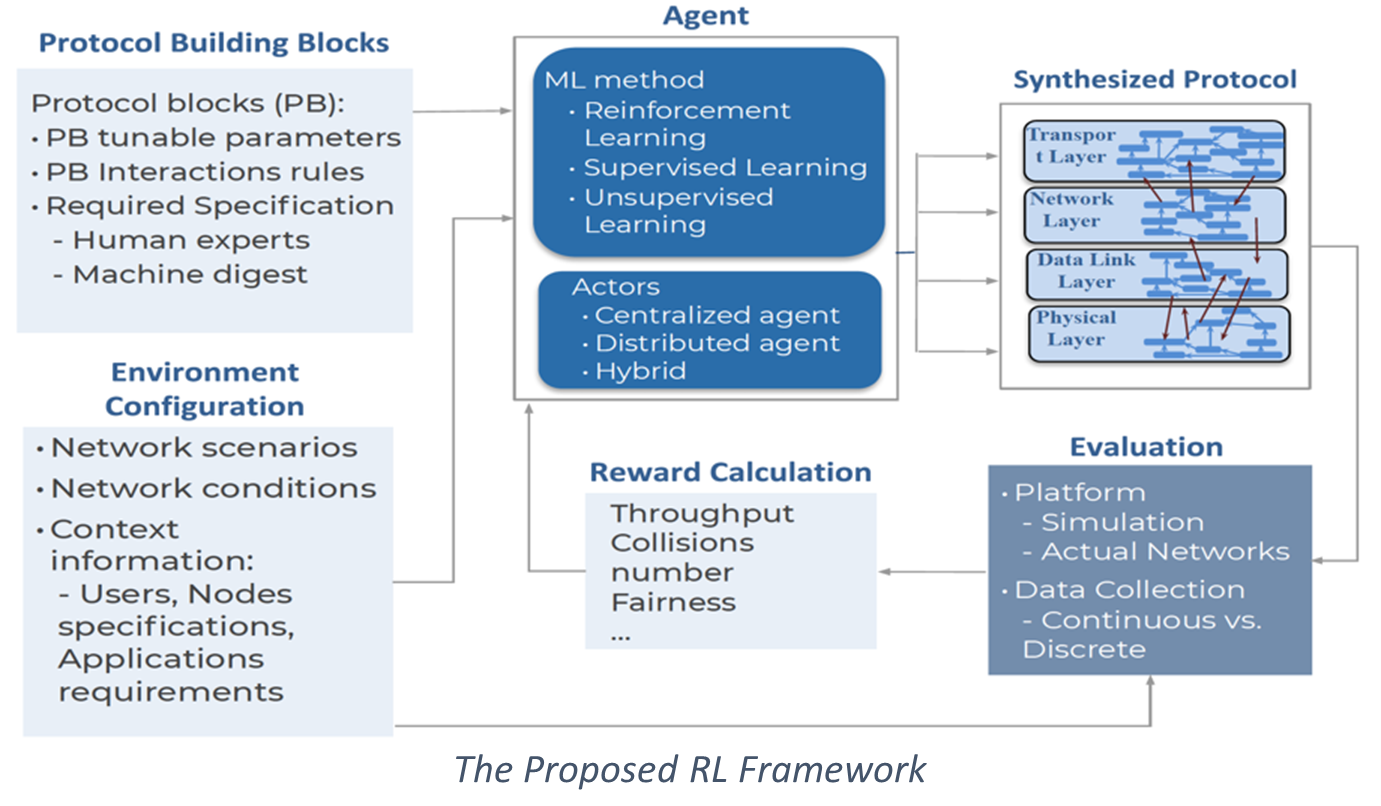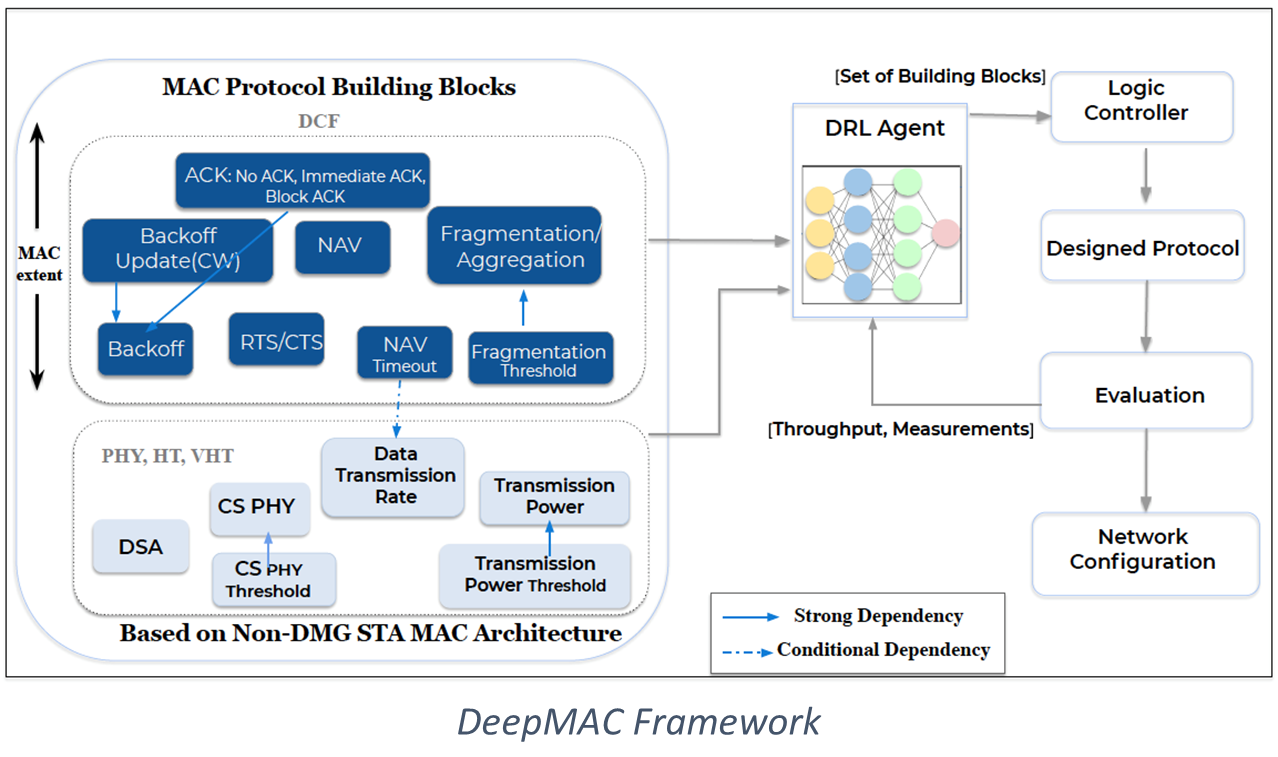DeepMAC – Towards A Deep Learning-Based Framework for Automated Design of Networking MAC Protocols
Overview
This significant growth and penetration of various devices is accompanied by an enormous increase in the number of applications supporting different domains and services. The increasing availability and performance requirements of these applications suggest that "general-purpose" protocol stacks are not always adequate and need to be replaced by application tailored protocols. Ideally, protocols (e.g., for routing, congestion control, video streaming, etc. will perform well across the entire range of environments in which they may operate. Unfortunately, this is usually not the case; a protocol may fail to achieve good performance if the network conditions deviate from assumptions implicitly or explicitly underlying its design, or due to specific implementation choices made by domain experts. However, while this approach is becoming increasingly difficult to repeat, these designed protocols are deeply rooted in rigid, cradle-to-grave designs and are therefore unable to meet the requirements of different network characteristics and scenarios. We believe that MAC protocols have the potential to outperform their human-designed process in some scenarios. ML-based protocols are not limited to human intuitions and may be capable of optimizing control-plane traffic and channel access in ways that are not yet seen. As a result of the heterogeneity and dynamically changing characteristics of networks (e.g., IoT), network protocol design requires a new approach in which control rule optimizations are not only based on a closed-form analysis of isolated protocols but are based on high-level policy objectives and a comprehensive view of the underlying components. It has therefore become crucial to re-engineer the protocol design process and migrate towards a vision of an intelligent design process that adapts and optimizes network protocols in a variety of environment contexts, such as device characteristics, application requirements, user objectives and network conditions.

In this project, we propose a novel DRL-based framework that is not only capable of tuning protocol parameters but also optimizes the main functionality of each protocol. In the proposed framework, a protocol is decoupled into a set of parametric modules as DRL inputs, each representing the main protocol functionality referred to as Building Blocks (BBs). This modularization technique helps to better understand the protocols generated, optimize the protocol design and analyze them systematically. These BBs and a set of other parameters are fed as input into the DRL agent. The DRL agent will then be able to learn what protocol blocks (components) are important for inclusion in or exclusion from the protocol design. Note that our proposed framework is generic in the design of networking and communication protocols across all layers of the network stack. we narrow down our focus to propose a DRL-based framework for designing wireless MAC protocols; DeepMAC, as a version of the proposed framework. In DeepMAC framework, MAC protocols are decoupled into a set of parametric modules, each representing a main functionality across popular flavors of 802.11 WLANs (IEEE 802.11 a/b/g/n/ac amendments). The DRL agent learns that when the load of the network is very low, it could eliminate control and sensing mechanisms (ACK and Carrier Sensing blocks, respectively) to increase the throughput of the channel by reducing the bandwidth overhead and waiting time introduced in these mechanisms. This framework could therefore serve as a tool for protocol designers to re-think the blocks used in a designed protocol. In addition, our framework could be utilized as a multivariate optimization tool that helps in alleviating the current protocol design process. Using this framework, domain experts provide the required specifications (objective) for a specific scenario as DRL input and could identify/capture the role that each protocol component (block) plays in varying scenarios for different objectives. It could also help domain experts to gain insight into the relation between different protocol components for different objectives, although such components may not have a direct dependency/relation to each other if considered alone.

Funding
- NSF CNS 1764185: "NeTS: Small: SMILE -- Towards Smarter Network Edges for Next Generation Networks”
Publications
- Hannaneh Pasandi, Tamer Nadeem. "Towards a Learning-Based Framework for Self-Driving Design of Networking Protocols", IEEE Access, vol. 9, pp. 34829-34844, March 2021.
- Hannaneh B. Pasandi, Hadi Amirpour, Tamer Nadeem, Christian Trimmer, “Learning-Driven MU-MIMO Group Scheduling for Multi-User Multimedia Applications Over Commodity WiFi”, The 1st ACM CoNEXT Workshop on Design, Deployment, and Evaluation of Network-assisted Video Streaming (VisNext 2021) in conjunction with The 17th International Conference on emerging Networking EXperiments and Technologies (CoNEXT), Munich, Germany, Dec., 2021.
- Hannaneh B. Pasandi, Tamer Nadeem. “Unboxing mac protocol design optimization using deep learning”, 2020 IEEE International Conference on Pervasive Computing and Communications Workshops (PerCom Workshops), Austin, TX, USA, 2020.
- Hannaneh Pasandi, Tamer Nadeem. "Mac protocol design optimization using deep learning", The 2nd IEEE International Conference on Artificial Intelligence in Information and Communication (ICAIIC 2020), Fukuoka, Japan, February 19-21, 2020.
- Hannaneh Barahouei Pasandi, Tamer Nadeem. “Towards a machine learning-based framework for automated design of networking protocols”, 2019 IEEE International Conference on Pervasive Computing and Communications Workshops (PerCom Workshops), pages 433–434. IEEE, 2019.
- Hannaneh Pasandi, Tamer Nadeem. "Challenges and Limitations in Automating the Design of MAC Protocols Using Machine-Learning", The 1st IEEE International Conference on Artificial Intelligence in Information and Communication (ICAIIC 2019), Okinawa, Japan, February 11-13, 2019.
Any opinions, findings, and conclusions or recommendations expressed in this material are those of the author(s) and do not necessarily reflect the views of the National Science Foundation.